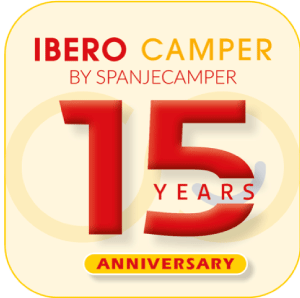By motorhome to the Sierras Subbéticas
Total freedom during your vacation, who doesn't want that? Going wherever you want and whenever you want. Waking up to the sound of the birds and then enjoying breakfast while overlooking the mountains. For this edition we went to the Sierra Subbética, in the south of the province of Córdoba. Nature, culture and activities as always, but this time with an extra adventure: we went out with the motorhome.
Text & photos: Maria Kupers
With thanks to Antonio Navas Pancorbo
What started as a wild idea became a reality in early May: together with Antonio, our ESpecial Life advisor for all things natural areas, I'm going on a couple of days of camping trips. This requires a little more thought in preparation than staying in a hotel and eating in restaurants, but very quickly proves to be absolutely worthwhile. Before leaving, Frank Ooms sends us some instructional videos on how to use the camper so we know exactly how everything works.
When we pick up the camper I am still shocked at how big it is, I don't have a truck driving license! Frank and Jessica understand my concerns but say that after ten kilometers it feels very normal to drive the huge camper.
We unpack our stuff (clothes, food, quilt) and marvel at the efficiency of the camper's interior. A toilet, shower, sitting area, kitchen, two single beds and a queen-size bed all in a 7 by 3 meter space. I conveniently take advantage of the fact that Antonio drives all kinds of vehicles because of his work and tell him to give him the credit for the first few miles. At first we are still being overtaken by trucks but indeed, after the first ten kilometers, Antonio says it feels fine to just keep the speed limit.
Sierras Subbéticas
Our destination is in the south of the province of Cordoba. We will visit several villages, bike a section of the Via Verde del Aceite and hike. Like every natural park in Andalusia, the Sierras Subbéticas has its own Centro de Visitantes. Located along the road between Cabra and Priego de Córdoba, it has a modernly furnished, extremely informative exhibit about the nature reserve.
The 32,000-hectare Sierras Subbéticas was included on the list of Geoparks by UNESCO in 2006. This means that the area contains important elements of geology, archaeology, rarity and beauty.
In the rolling countryside surrounding the mountain area are olive and almond groves and grain fields. In the mountains themselves, you can abseil, rock climb, bungee jump and raft, among other things.
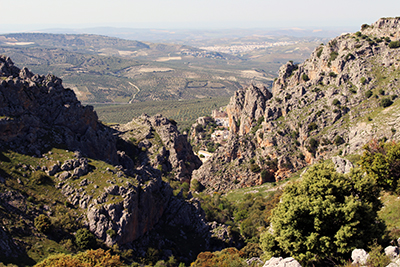
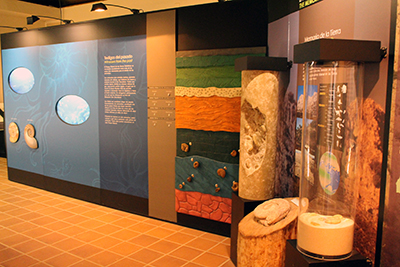
We take it a little easier this time and choose the Río Bailón hiking trail (there are several versions on wikiloc). That route goes along a river and if it has rained a lot there are several waterfalls to be seen. Unfortunately, the latter was not the case but that did not make the hike any less beautiful. Before entering the area around the river you must ask permission from the Centro de Visitantes. Since we were there anyway, we asked that right away for the next day and got it without any problem. That permission applies to the starting point in Zuheros as well as the one in Cabra.
The test of oil in the pan
The advantage of a camper is that you decide when and where to eat. From the Centro de Visitantes we drive to the Santuario de la Virgen de la Sierra. Before visiting the chapel, we decide to prepare our lunch. In a flat area full of wildflowers, we set up our folding chairs and get to work. As we pour the oil into the frying pans, we notice that it slides to one side. So we are not quite on level ground...just a matter of turning the omelet and the piece of meat around in the pan a little more often and it is just as tasty.
The chapel of the Virgen de la Sierra was built in the thirteenth century after legend has it that the Virgin Mary appeared to a shepherd in a cave there. In the eighteenth century, the chapel was converted into a small church that houses the statue of the Virgen. In 2007 the entire building was restored and the surrounding area was also taken care of, there is a small store, a restaurant, several vantage points and there are restrooms for the many visitors.
Throughout the year there are processions by brotherhoods from all over Andalusia that pay their homage to the Virgin. On Sept. 4 at 4 p.m., believers from Cabra (15 kilometers away) bring the statue on foot from the mountain to the Iglesia de la Asunción y Angeles. There it will remain for a month so that everyone in the village can visit the patron saint there.
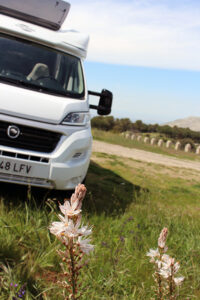
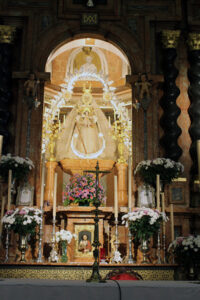
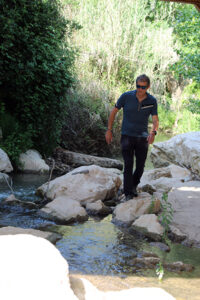
Oldest bridge
At the Centro de Visitantes we were given a stack of leaflets and saw that there is still a bridge from the time of the Caliphate nearby. Since we have already come across signs saying "Ruta del Califato" everywhere, we feel that this piece of history should not be missing from our trip.
On the map we see that it is close to Carcabuey so we trust that we will see the familiar pink sign with the name of the monument somewhere. Luck is with us, at the beginning of the walking route is a spacious parking lot with tall trees.
Through the burning sun we walk the 1.3 kilometers past olive trees, bits of river and vegetable gardens to the bridge. It turns out to be in scaffolding. Too bad for the photo but good for the preservation of this small arch bridge from the tenth century. In any case, everywhere we go we notice that much has been restored in recent years, at least the rich history of Andalusia is not lost.
Fortunately, the restoration enthusiasm is not exaggerated. At the castles of Carcabuey and Zuheros, for example, only those parts have been renewed that were really about to collapse. You get a good idea of what it must have looked like in the past, without it seeming fake.
A sleeping place with thousands of stars
After a refreshing beer in the town square in Carcabuey, we start looking for a place to spend the night. We know that there are several places in the neighborhood that are specially set up for camper vans but we actually want to avoid them and search google maps for an "area recreativa. When we get there, there is already a camper with a British license plate whose owner is waving to us very enthusiastically. We look at each other and simultaneously say 'al Santuario'. We drive up the Virgen de la Sierra mountain again and with a view of the valley and the mountains in the distance we enjoy our dinner.
It's a bit of trial and error to get everything ready for the night, because when the front bed is pulled down you are left with about a square meter so you can go to the toilet but you can't go outside. We pull the curtains around the beds closed and then everything is quiet.
The mattresses are great, the only small drawback is that the camper rocks a little when someone turns over. The blinds keep out the light so well that we don't wake up until about eight o'clock, by which time the sun has been shining over the plain where we are.
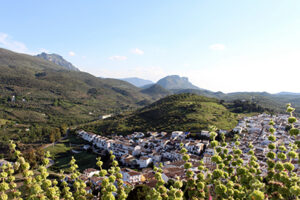
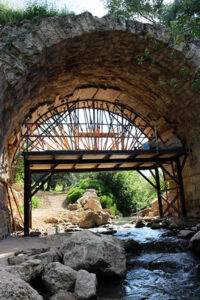
Cycling on the Vía Verde
The Vía Verde del Aceite is a 128-kilometer former train route between the city of Jaén and Puente Genil. In 1893, the railroad was built to transport the products of mining in the Linares area (Jaén province) to the ports of Málaga and Algeciras. Since olive oil was also transported in large tank cars, the line was nicknamed "Tren del Aceite.
The purpose of the route was to ensure economic prosperity in the interior but it never really succeeded in the end. In 1941, the government took over the route and transferred it to the then newly formed railroad company RENFE.
When a train derailed at Alcaudete in 1984, they decided not to invest any more in repairs and the entire line was discontinued.
Like many other old train routes, the Via Verde del Aceite has been transformed into a route where you can bike and walk. Along the way you pass several stations where you can spend the night, even with a camper, and have something to eat or drink.
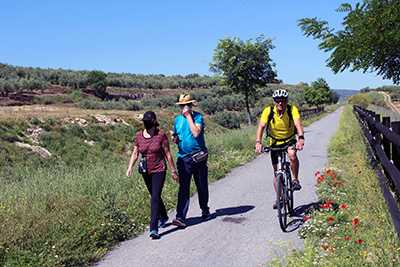

We have bikes with us so decide to park at the Luque train station to go from there to Zuheros. We ride through the fields, overlooking the countryside and the mountains of the Sierras Subbéticas. The path is well maintained and we meet several groups of cyclists and hikers. The little station of Zuheros is at the foot of the mountain on which the village is built. To get there we have to get off the Via Verde and climb quite a bit. We decide to go back and then take the camper to the village.
Planning required
Since it has already happened to both of us with our own cars that we more or less got stuck in narrow streets, entering a center with the camper van would be really stupid. On googlemaps we look for a place where we will have enough space to park, rather walk a little further than get stuck somewhere.
Zuheros is definitely worth a visit. At the entrance to the village is a big sign that it is recognized as one of the most beautiful villages in Spain, and we agree.
Narrow streets, an impressive castle on the tip of the rock, flowers almost everywhere and everything very clean. There are not many terraces and nothing is signposted in English anywhere either, an authentic Andalusian village thus not overrun by tourists.
We would have liked to visit the nearby Cueva de los Murciélagos but you have to make a reservation for that, so we hadn't planned to. Although the name suggests that you will only see bats, this largest cave in the province of Cordoba is best known for its Stone Age wall paintings and the remains of a 4,745-year-old skeleton found there last century.

Tree of love
Spain is the second largest almond producer in the world, and some of those almonds come from the Sierras Subbéticas. Writings show that there were almond trees in Spain as early as the seventh century B.C. The Romans and Arabs were the ones who started growing almonds on a larger scale. Because the almond tree is the first tree to bloom, the blossom is seen as a sign of new beginnings, light, fertility and love. Therefore, in some countries, almonds are still thrown at bridal couples or wedding guests are given a bag of sugared almonds to take home.
In the hamlet of Zamoranos, near Priego de Córdoba, stands the almond museum of the Morales family business. They have been growing, processing and exporting almonds since 1910, and in the exhibition hall you get a good idea of how it used to be done. All the old machines have been thoroughly refurbished so it may look a little too slick but the love for the trade is obvious. You can also see the many types of almonds there are and of course you can buy some nice souvenirs to take home.
Priego de Córdoba
For years I have been hearing enthusiastic stories about Priego de Córdoba, so we absolutely must go there. The old city center is full of monuments, mostly in the Baroque style (seventeenth century) and Priego is quite unique in that. You can visit the many churches and museums and, of course, the castle from the time of the Arabs. The narrow streets that open out onto colorful squares with fountains invite you to a relaxing walk with regular breaks at one of the many terraces.
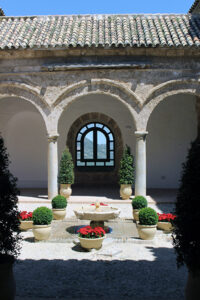
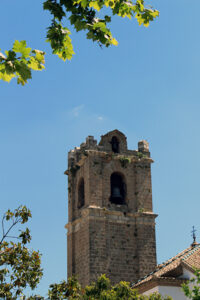
Freedom on wheels
As we drive past the huge reservoir of Iznájar back towards Málaga, we come to the conclusion that we would actually like to drive on for a weekend at the beach of Cadiz. And while we are on the road, we would like to spend a few days in Doñana afterwards. In short, we enjoyed this adventure very much.
It is very pleasant to be able to decide where to spend the night, officially it is not allowed everywhere, but this time we ignored the rules. Finding a suitable place is not always easy, because the most beautiful places in nature are not accessible with a camper. But with googlemaps and some time to explore the area, something can always be found. The same goes for a place to cook, there are several "areas recreivas" along the road and special camper car parking areas where you can go.
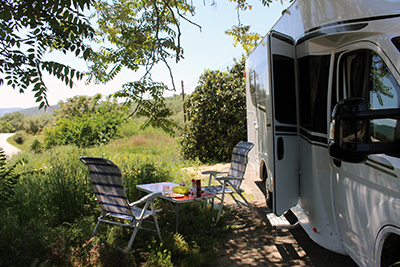
In the app park4night you will find all the information from campers about places to park, spend the night, fill up with water and discharge dirty water and chemical toilet. The camper itself is extremely comfortable and after getting used to it, also excellent to drive. When I then get behind the wheel of my own car again I find it very small and so low on the road. The vacation is over but as the Spanish say so beautifully, "nadie me quita lo bailado".
Learn more
www.iberocamper.com
www.turismozuheros.es
www.turismodelasubbetica.es
www.almendrasfmorales.com
This article appeared in ESpecial Life Magazine in June 2021. www.especial-life.com
Shopping tip from Iberocamper From this area comes the very best olive oil in Spain. And probably the best in the world! A nice gift-wrapped souvenir can be purchased directly on the road to Carcabuey in the shop of the cooperative Almazaras the
Read the other blogs here!



